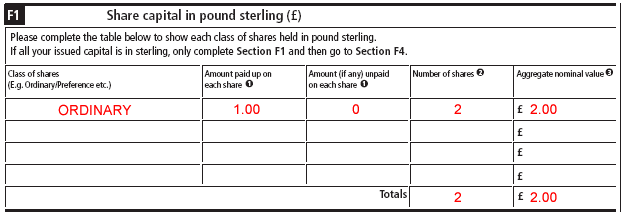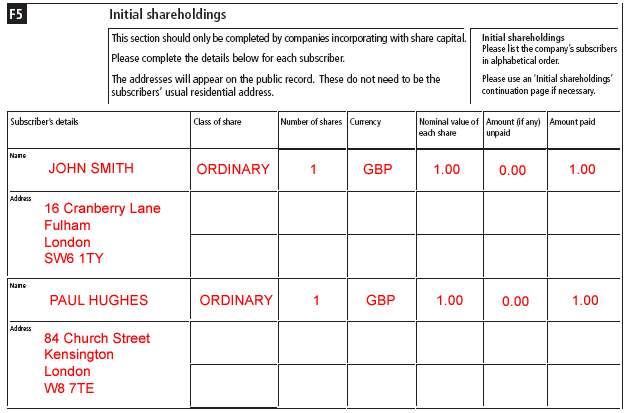 | Getting started | What you will need | Part 1 | Part 2 | Part 3 / Part 4 | Part 5 | Finalising |  |
Form a Limited Company Electronically - £13.95Typical 3-4 hour turnaround. Filing fees included. Click here to find out more |
PART 3 STATEMENT OF CAPITAL
(Companies Having a Share Capital)If you wish to form a company limited by guarantee (not-for-profit) then please skip part 3 and continue to part 4 (statement of guarantee) of the application form.
The purpose of shares
Shares are the principle means of forming and investing in a company. When you incorporate your company you will issue a certain number of shares to the owners of the company. These shares will usually carry a nominal value of £1.00 and can act as a vehicle for injecting capital into the new company. The shareholders title to the company will be proportionate to the number of shares they own comparative to those held by the other shareholders.
Statement of Capital
The statement of capital is a snapshot showing the currency, type (e.g. ordinary/preference), associated rights and denomination of the company's shares. A company can hold more than one class of share; each will have different rights and values. The statement of capital information is entered into sections F1 to F4.
Below you will find a description of the terms used in the statement of capital section on form IN01.
1. Class of shares
There are several recognised types of shares that you may declare here, by far the most common are ordinary shares. You may also create preffered shares that carry additional priveledges. For a full explanation of the different types of shares please see the link below.
An overview of share types
2. Amount paid/unpaid on shares
Shares can be issued without being fully paid up. This may allow the company to call for payment at a later date. Shares can also be issued and considered as paid up without any monetary transaction.
3. Number of shares
This relates to the number of shares issued. For a single member company this can be simply one share issued to the principle owner of the company.
Following October 1st 2009 the requirement to have an authorised limit to the number of shares you can issue was scrapped.
4. Aggregate nominal value
The aggregate nominal value is the total value of the shares in issue. This is calculated by multiplying the number of shares in issue by the nominal share value.
5. Share currency
Most UK companies denominate their share capital in GBP (Pound Sterling). It is however possible to specify any other currency and such share capital information can be entered in section F2.
The example below shows how two shares are created with a nominal value of GBP 1.00. The total aggregate share capital is GBP 2.00

Prescribed Particulars (F4)
The prescribed particulars describe the rights associated with a given class of share. In Section F4 you can enter the voting rights, dividend entitlement and any liability for the shares to be redeemed by the company.
In most cases it will not be necessary to stipulate any additional rights beyond those inferred in the Companies Act 2006. In such instances the following statement will be appropriate:
Ordinary shares with no special voting or dividend rights beyond those prescribed in the Companies Act 2006.
Initial Shareholdings (F5)
The members of a company limited by shares are referred to as shareholders. In section F5 you will issue a certain number of shares created in the previous section to the initial shareholders (subscribers).
The ownership of a company is determined by the percentage of issued share capital that each shareholder owns. The following examples describe some common scenarios:
Shareholder A owns 1 share and Shareholder B also owns 1 share. Each shareholder will own 50% entitlement to the company.
Shareholder A owns 1 share and shareholder B owns 3 shares. The percentage ownership of the company is 25% and 75% respectively. Shareholder B has controlling interest.
Shareholder A owns 51 shares and shareholder B owns 49 shares. The percentage ownership of the company is 51% and 49% respectively. Shareholder A has controlling interest.
Obviously if you just have one shareholder, they will retain 100% ownership of the company irrespective of how many shares they hold. In most cases only 1 share would be issued for single member companies.
When you have decided on the distribution of shares you can enter the shareholders in section F5. The class of share, currency and values will related to those that have been declared in the statement of capital. The example below assumes there are two shareholders and follows on from the statement of capital example above:

Please note: Your application will be declined if you issue more shares in section F5 than those originally specified in section F1.
| Back Continue |
Recent Support Articles
- 14 Nov 2025 - Company Formation Wizard Services: VAT Registration, Company Formation & Stationery
- 14 Nov 2025 - Companies House Verification Overview
- 14 Nov 2025 - Companies House Verification Code Service
- 23 Oct 2025 - Privacy Policy
- 20 Oct 2025 - Identity Verification Changes - Effective 18 November 2025
